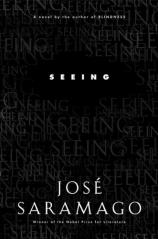Seeing
Review
Seeing
Four years ago the nation's capital suffered a bizarre and debilitating plague of unexplained white blindness. Everyone, save one woman, was blind and she helped a small group to survive during the catastrophe. Such was the premise of Nobel Prize-winning Portuguese author Jose Saramago's amazing novel BLINDNESS. His latest, SEEING, has the capital again in crisis; this time political calamity ensues when about 70 percent of the paper ballots of the recent election are blank.
The government goes into a tailspin, assuming the blank votes reflect a subversive, anarchist movement. The egotistical national leaders devise a plan to regain control of the capital; they put the city under siege. Although casting blank ballots is not illegal, the capital is physically isolated from the rest of the country by a military barrier. The police and army are withdrawn from the city as well as many national and local leaders. The government hopes that the isolation and desperation the siege causes result in the capital cooperating once again in their version of democracy.
However, the citizens of the besieged capital rally together, take care of each other, and their opinion of the government and the current leadership pales. The government struggles to understand what the blank votes mean and come to interpret them as a new plague of "blankness" attacking the capital.
As the corruption of the government grows more and more apparent, a letter arrives indicating that one woman, who did not go blind during the plague of blindness and who murdered a man during that time, is responsible for the conspiracy of blank votes. The second part of the novel follows a police inspector who is snuck into the city to investigate the claim, as he comes to know the woman and begins to see the absurdity of the government's position.
Saramago's style is Kafkaesque (although he is influential and talented enough to have other works referred to as Saramagoesque). The government, in this case right-wing, is shadowy and absurd; a frustrating and uncaring institution. The citizens of the capital are punished although no crime has been committed and the punishment itself is dramatic and Draconian. The inspector struggles to break free of the system he knows can and probably will destroy him; there is little hope for justice. Saramago's style is also about run-on sentences and the lack of traditional quotation marks. This can be an obstacle for some readers but commitment to the book is rewarded. After a bit of a slow start, the pace and rhythm of the story picks up and overall this is a very compelling and timely tale.
SEEING is less successful than Saramago's masterpiece BLINDNESS, but it is still a wonderfully executed and highly recommendable read. Saramago further solidifies himself as the post-modern heir of authors such as Albert Camus, Thomas Mann and Franz Kafka.
And having read BLINDNESS is in no way requisite for reading SEEING, which works well as a stand-alone story of corruption, fear, politics and the meaning of both terrorism and democracy.
Reviewed by Sarah Rachel Egelman on January 23, 2011
Seeing
- Publication Date: April 10, 2006
- Genres: Fiction
- Hardcover: 320 pages
- Publisher: Houghton Mifflin Harcourt
- ISBN-10: 0151012385
- ISBN-13: 9780151012381





